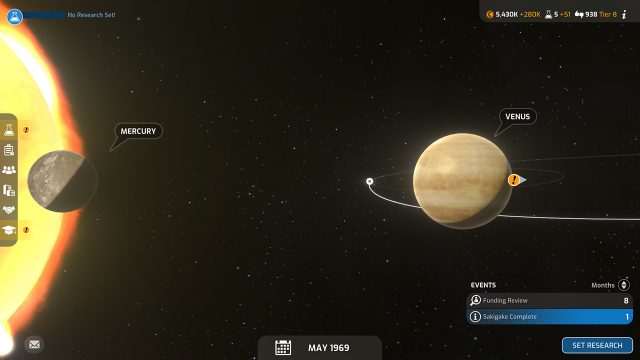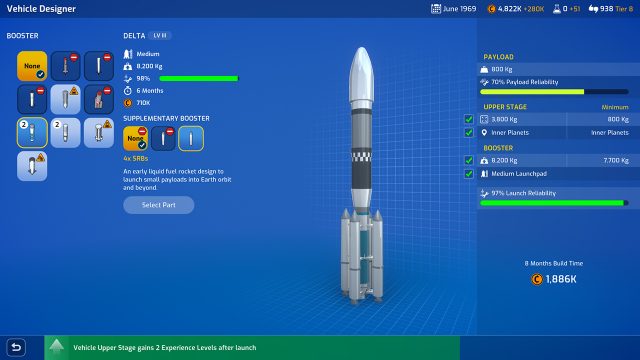Educational opportunities; addictive gameplay; good planning is rewarded
Repetitive minigame; too much emphasis on the race and not enough on the wonders of space
Not to brag or anything, but I was the founder and president of my high school astronomy club. Outer space is kind of a big passion of mine. I’ve been to both NASA’s Space Center in Houston and NASA’s Kennedy Space and Science Center in Cocoa Beach. I’ve been to a book signing by Buzz Aldrin and even spent the night on the aircraft carrier that picked up the Apollo 11 astronauts after their landing back on Earth.
Despite my love for outer space, I have not played very many space themed games as most don’t seem to capture the wonder, curiosity, and desire for exploration that I wish they would. Though MARS Horizon captures some of the feelings relating to the massive achievements involved in space travel, in some ways those magical feelings seem vacant. However, MARS Horizon is a very well executed management simulation game with great educational potential that had me hooked as soon as the tutorial was over.
At the start, MARS Horizon lets you choose to play as NASA, the European Space Agency (ESA), China, Russia, or Japan. Each space agency has their own flag, headquarters, traits, and realistic diplomatic relations with other nations. Traits are extra bonuses or detractions to the player, and diplomatic relationships with other agencies affect likelihood of joint missions and funding. Luckily, all aspects for each agency are customizable including the flag. The developers even created unique flags to choose from — some that will look very familiar to Star Trek fans. The game also has three difficulty modes: Explorer, Pioneer, and Veteran.
The tutorial feels both long and dense with information. At one point, I even considered taking notes as I was worried I might forget something. Fortunately, the controls are intuitive and the gameplay is cyclical and repetitive enough to not feel overwhelming but so addicting that it had me up till early hours with the constant tasks that needed tending to and the anticipation to see my plans carried out.
The game progresses from month to month and there are three main resources to keep track of: finances, science, and support. All of which you want to constantly grow. You play as the director to your space program. As director, you receive a set amount of money each month to spend on construction. This can be used on various things like vehicles, buildings, and paying your astronauts. How much money you receive is dependent on which tier you are in. You work your way up tiers by receiving more public support. Support is gained by completing missions successfully, how you interact with other agencies, and how you are faring in the race to space. The final resource, science, is predominately gained from missions but can come from other sources. Science is spent on researching new missions, vehicle types, and buildings. Each month you keep track of the status of your research, current missions, construction at your headquarters, astronauts, and diplomacy. To stay ahead of the other agencies, you will need to keep regular tabs on other countries schedules as well.
The game begins with your agency’s first test launch in January of 1957. Depending on which agency you choose, you will have access to different types of rockets and payloads. The design of your headquarters will also reflect the country you are in. Each headquarter has a limited area to construct buildings. Each building offers different perks, so choose carefully which ones to research and construct.
You will also be designing and constructing rockets. Don’t worry, it’s not rocket science. You create your rocket by choosing from your already unlocked or yet-to-be researched vehicles. All you need to do is choose an upper stage that can support your payload, what you are sending into space, and a booster that can support the upper stage. After that, you can consider build time, cost, and other aspects.
Once in space, you will be tasked with acquiring a certain amount of different types of resources. This clever minigame may feel a bit like solving a math equation which is apt. Essentially, a required minimum of certain resources must be gained before your turns run out. Certain resources can be traded for others, so you must think carefully and outline your course of action if you want bonuses. This minigame does get repetitive and by the end of the game you may be sick of it. Fortunately, there is enough variation that it doesn’t get too boring or frustrating.
The space nerds like myself will be happy to know that the game was made with support from the ESA and the UK Space Agency. For players newly interested in the history of space exploration, the game offers a “Spaceopedia” with articles on the different agencies, space eras, milestones in space exploration, rocket types, and more.
A drawback to the game is that the drive to continue is the race, not the scientific achievement or curiosity. I was compelled to continue so that I could send an animal into space before Russia or beat the ESA to the moon, but none of the scientific ingenuity made by the real engineers or the courage and eagerness of astronauts is demonstrated. This makes the game feel more like a strategic race rather than driven exploration or the desire for knowledge, i.e. what is the driving motivation for many if not most astronauts, astronomers, rocket scientists, astrophysicists, and those who are fascinated by outer space. Though it was fun to see the animations of my agency’s flag planted on the moon by an astronaut, it didn’t ignite in me further desire to keep exploring space or make it to Mars. I understand the importance that competition played in the real life space exploration of the 1950s and 1960s. It was literally called the Space Race! Yet, I wish the wonder and amazement in discovery and scientific achievement could have also been illustrated. It is in this way that MARS Horizon wasn’t the perfect space game for me.
Though it isn’t the perfect space game, it’s a pretty darn good one. It gives you so much to think about, but it never feels overwhelming thanks to the three difficulty settings. A casual player will have a great time with the Explorer setting, whereas fans of resource management games who love to strategize will enjoy the Veteran setting. The game is also educational and a great way to get newcomers interested in space.
Nintendojo was provided a copy of this game for review by a third party, though that does not affect our recommendation. For every review, Nintendojo uses a standard criteria.




 ShareThis
ShareThis







